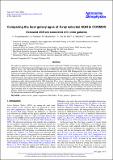Por favor, use este identificador para citar o enlazar a este item:
http://hdl.handle.net/10261/335250COMPARTIR / EXPORTAR:
 SHARE SHARE
 CORE
BASE CORE
BASE
|
|
| Visualizar otros formatos: MARC | Dublin Core | RDF | ORE | MODS | METS | DIDL | DATACITE | |

| Título: | Comparing the host galaxy ages of X-ray selected AGN in COSMOS: Obscured AGN are associated with older galaxies |
Autor: | Georgantopoulos, Ioannis; Pouliasis, Ektoras; Mountrichas, George CSIC ORCID; Van der Wel, A.; Marchesi, S.; Lanzuisi, G. | Palabras clave: | Galaxies: nuclei Quasars: supermassive black holes X-rays: galaxies Galaxies: active |
Fecha de publicación: | 2023 | Editor: | EDP Sciences | Citación: | Astronomy and Astrophysics 673: A67 (2023) | Resumen: | We explore the properties of the host galaxies of X-ray selected AGN in the COSMOS field using the Chandra Legacy sample and the LEGA-C survey VLT optical spectra. Our main goal is to compare the relative ages of the host galaxies of the obscured and unobscured AGN by means of the calcium break Dn(4000) and the Hδ Balmer line. The host galaxy ages are examined in conjunction with other properties such as the galaxy stellar mass, and star-formation rate as well as the AGN Eddington ratio. Our sample consists of 50 unobscured or mildly obscured (NH < 1023 cm−2) and 23 heavily obscured AGN (NH > 1023 cm−2) in the redshift range z = 0.6 − 1. We take specific caution to create control samples in order to match the exact luminosity and redshift distributions for the obscured and unobscured AGN. The majority of unobscured AGN appear to live in young galaxies in contrast to the obscured AGN which appear to live in galaxies located between the young and old galaxy populations. This finding may be in contrast to those evolutionary AGN unification models which postulate that the AGN begin their life in a heavy obscuration phase. The host galaxies of the obscured AGN have significantly lower levels of specific star-formation. At the same time the obscured AGN have lower Eddington ratios indicating a link between the star-formation and the black hole accretion. We find that the distribution of the stellar masses of the host galaxies of obscured AGN is skewed towards higher stellar masses in agreement with previous findings. Our results on the relative age of obscured AGN are valid when we match our obscured and unobscured AGN samples according to the stellar mass of their host galaxies. All the above results become less conspicuous when a lower column density (log NH(cm−2) = 21.5 or 22) is used to separate the obscured and unobscured AGN populations. | Versión del editor: | https://doi.org/10.1051/0004-6361/202244875 | URI: | http://hdl.handle.net/10261/335250 | DOI: | 10.1051/0004-6361/202244875 | E-ISSN: | 1432-0746 |
| Aparece en las colecciones: | (IFCA) Artículos |
Ficheros en este ítem:
| Fichero | Descripción | Tamaño | Formato | |
|---|---|---|---|---|
| comparincosmos.pdf | 1,85 MB | Adobe PDF |  Visualizar/Abrir |
CORE Recommender
SCOPUSTM
Citations
5
checked on 18-may-2024
WEB OF SCIENCETM
Citations
2
checked on 20-feb-2024
Page view(s)
20
checked on 21-may-2024
Download(s)
9
checked on 21-may-2024
Google ScholarTM
Check
Altmetric
Altmetric
Este item está licenciado bajo una Licencia Creative Commons

